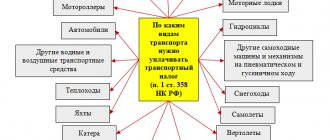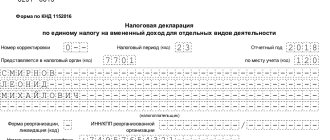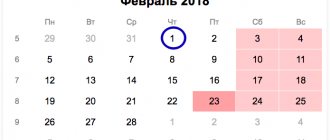Transport tax for 2014
Starting this year, changes in legislation regarding transport tax come into force. For example, now taxpayers must focus on the rates, procedure and deadlines for paying this tax established in the region. However, the calculation of transport tax for 2014 remained the same.
A number of changes that do not affect the calculation of tax came into force in 2015. In particular, it is clarified that when establishing a tax, the legislative (representative) bodies of the constituent entities of the Russian Federation determine the tax rate within the limits established by Chapter. 28 Tax Code of the Russian Federation. In relation to taxpayer organizations, the legislative (representative) bodies of the constituent entities of the Russian Federation, when establishing a tax, also determine the procedure and deadlines for paying the tax. The legislator also specified two categories of transport tax payers: organizations and individuals. Individual entrepreneurs will now pay tax as individuals; By the way, for this category of taxpayers the tax is now paid no later than October 1 of the year following the expired tax period.
IMPORTANT IN WORK
Payers of transport tax are persons to whom vehicles are registered, regardless of the actual operation of the vehicle.
In addition, since 2015, taxpayers-organizations calculate the amount of advance tax payments taking into account the increasing coefficient specified in paragraph 2 of Art. 362 Tax Code of the Russian Federation. The deadline for making advance payments does not change (at the end of each reporting period in the amount of one-fourth of the product of the corresponding tax base and tax rate).
Tax rates have also increased in many regions. For example, in the Volgograd region, the tax rate for passenger cars with an engine power of up to 100 hp. With. (up to 73.55 kW) inclusive is 9.00 rubles. with every horsepower.
GOOD TO KNOW
Taxpayers classified as the largest in accordance with Art. 83 of the Tax Code of the Russian Federation, submit tax returns to the tax authority at the place of registration as the largest taxpayers.
Transport tax declaration
Taxpayers-organizations, after the expiration of the tax period, submit a tax return for transport tax to the tax authority at the location of the vehicles (clause 1 of Article 363.1 of the Tax Code of the Russian Federation). From January 1, 2011, during the tax period, calculations for advance payments for transport tax are not submitted to the tax authority.
Tax returns for transport tax are submitted by taxpayer organizations no later than February 1 of the year following the expired tax period (clause 3 of Article 363.1 of the Tax Code of the Russian Federation). The right to change this period is not granted to constituent entities of the Russian Federation (letter of the Ministry of Finance of Russia dated March 15, 2006 No. 03-06-04-04/08).
If the organization does not have vehicles that are subject to taxation in accordance with Art. 358 of the Tax Code of the Russian Federation, the organization is not recognized as a taxpayer, and therefore does not have to submit transport tax returns. Individuals, including individual entrepreneurs, do not submit a transport tax return.
The form of the tax return for transport tax, as well as the procedure for filling it out, were approved by order of the Federal Tax Service of Russia dated February 20, 2012 No. ММВ-7-11/ [email protected] For 2014, it is necessary to report on this form, taking into account the changes made by the order of the Federal Tax Service of Russia dated April 25. 2014 No. ММВ-7-11/ [email protected]
Features of filing a declaration during reorganization
IMPORTANT IN WORK
The obligation to pay taxes of a reorganized legal entity is assigned to its legal successor(s) in the manner established by Art. 50 Tax Code of the Russian Federation.
Reorganization of a legal entity does not change the deadlines for the fulfillment of its obligations to pay taxes by its legal successor(s). Consequently, the legal successor(s) pays transport tax within the time limits established by the laws of the constituent entities of the Russian Federation (clause 1 of Article 363 of the Tax Code of the Russian Federation). Also, the successor (successors) of the reorganized legal entity in the execution of the provisions imposed on him by Art. 50 of the Tax Code of the Russian Federation, the obligation to pay taxes and fees enjoys all rights, fulfills all obligations in the manner prescribed for taxpayers (clause 2 of Article 50 of the Tax Code of the Russian Federation).
A tax return is submitted by each taxpayer for each tax payable, unless otherwise provided by the legislation on taxes and fees (clause 1 of Article 80 of the Tax Code of the Russian Federation). Thus, when reorganizing a legal entity, a tax return for transport tax is submitted to the tax authority by the legal successor(s) in the manner prescribed by Art. 363.1 Tax Code of the Russian Federation. In this case, the last tax period for the reorganized organization is determined in the manner established by clause 3 of Art. 55 Tax Code of the Russian Federation.
If the vehicles of a reorganized organization are transferred to a legal successor, the legal successor of the reorganized organization is obliged to submit a single transport tax return for the entire tax period. In the declaration, it is necessary to calculate the amount of transport tax in relation to all vehicles previously owned by the reorganized organization and accepted on the balance sheet of newly established legal entities (letter of the Federal Tax Service of Russia dated November 11, 2010 No. ShS-37-3/15203, Federal Tax Service of Russia for Moscow dated May 24 .2011 No. 16-15/ [email protected] ).
When submitting to the tax authority at the place of registration by the successor organization a declaration for the last tax period and updated declarations for the reorganized organization (in the form of merger with another legal entity, merger of several legal entities, division of a legal entity, transformation of one legal entity into another) in the Title Page according to the details “at the location (registration)”, the code “260” or “216” is indicated (Appendix No. 3 to the Procedure for filling out the declaration, approved by order of the Federal Tax Service of Russia dated February 20, 2012 No. ММВ-7-11 / [email protected] ), and in its upper part the TIN and KPP of the legal successor are indicated. The “taxpayer” detail indicates the name of the reorganized organization. The OKTMO code is indicated for the municipality in whose territory the reorganized organization or its separate divisions were located. The details “TIN/KPP of the reorganized organization” indicate, respectively, the TIN and KPP that were assigned to the organization before the reorganization by the tax authority at its location. Codes of reorganization forms and the organization's liquidation code are given in Appendix No. 2 to the Procedure.
Tax base for transport tax
The tax base for transport tax is determined:
1) as the vehicle engine power in horsepower (hp) - in relation to vehicles with engines, with the exception of vehicles specified in paragraphs. 1.1 clause 1 art. 359 of the Tax Code of the Russian Federation.
The engine power is established based on the technical documentation for the corresponding vehicle and is indicated in the registration documents, in particular, in the vehicle passport (PTS) (clause 18 of the Methodological Recommendations approved by Order of the Ministry of Taxes of Russia dated 04/09/2003 No. BG-3-21/177) .
According to paragraph 19 of the Methodological Recommendations, if in the technical documentation for a vehicle the engine power is indicated in metric power units (kW), the corresponding recalculation into non-system power units (horsepower) is carried out by multiplying the engine power, expressed in kilowatts, by a multiplier, equal to 1.35962 (conversion factor: 1 kW = 1.35962 hp). This is equivalent to the expression 1 l. With. = 0.73549875 kW (letter of the Ministry of Industry and Trade of Russia dated October 18, 2012 No. 20-3729). In this case, the final result must be rounded to the second decimal place.
The engine power of the vehicle is not indicated in the vehicle title in horsepower. According to the PTS, the engine power in metric power units is 184 kW.
The tax base for the purpose of calculating transport tax will be:
184 kW x 1.35962 = 250.17 l. With.
2) as the nameplate static thrust of a jet engine (the total nameplate static thrust of all jet engines) of an air vehicle during take-off in terrestrial conditions in kilograms of force - in relation to air vehicles for which the thrust of a jet engine is determined (clause 1.1, clause 1, art. 359 Tax Code of the Russian Federation);
3) as gross tonnage in registered tons - in relation to non-self-propelled (towed) water vehicles for which the gross tonnage is determined (clause 2, clause 1, article 359 of the Tax Code of the Russian Federation). Gross capacity is established based on the technical documentation for the corresponding vehicle and is indicated in the registration documents (clause 21 of the Methodological Recommendations);
4) as a unit of transport in relation to water and air vehicles not specified in paragraphs. 1, 1.1 and 2 clause 1 art. 359 of the Tax Code of the Russian Federation. Water vehicles for which a tax per unit of vehicle is established include, for example, floating cranes, floating dredging equipment, landing stages and other floating structures that do not have engines for independent movement (clause 23 of the Methodological Recommendations).
ORIGINAL SOURCE
The tax base is determined for each vehicle in relation to the vehicles specified in paragraphs. 1, 1.1 and 2 clause 1 art. 359 of the Tax Code of the Russian Federation. In relation to the vehicles specified in paragraphs. 3 p. 1 art. 359 of the Tax Code of the Russian Federation, the tax base is determined separately.
— Clause 2 of Art. 359 of the Tax Code of the Russian Federation.
In the event of a discrepancy between the information submitted to the state bodies carrying out state registration of the relevant types of vehicles and the data contained in the technical documentation for the vehicle, the data contained in the technical documentation is accepted. In the absence of data on engine power (gross capacity) in the technical documentation for the vehicle, to determine engine power (gross capacity), an expert opinion submitted by the taxpayer or the results of an examination conducted in accordance with Art. 95 of the Tax Code of the Russian Federation (clause 22 of the Methodological Recommendations, clause 2 of the letter of the Department of Tax Administration of the Russian Federation for the city of St. Petersburg dated June 26, 2003 No. 07-04/1307). For water vehicles, when determining the tax base, the power of the vessel's engines registered with the water vehicle is taken into account (clause 20 of the Methodological Recommendations).
POSITION OF THE MINISTRY OF FINANCE
For the purpose of calculating transport tax for hybrid cars (cars with engines running on different types of energy, for example, a gasoline and an electric motor), the combined or total power of the two engines is taken into account as the tax base for the transport tax.
— Letter of the Ministry of Finance of Russia dated October 31, 2012 No. 03-05-07-04/18.
Procedure for calculating transport tax
The amount of transport tax payable to the budget at the end of the tax period is calculated for each vehicle as the product of the corresponding tax base and tax rate, unless otherwise provided by Art. 362 of the Tax Code of the Russian Federation.
Formula for calculating transport tax:
TN = NB x STN,
Where
TN – transport tax (for the tax period) (rub.);
NB – tax base determined in accordance with Art. 359 Tax Code of the Russian Federation;
STN – transport tax rate (rub.).
The amount of tax payable to the budget by taxpayer organizations for the tax period is determined as the difference between the calculated amount of tax and the amounts of advance tax payments payable during the tax period. When establishing a transport tax, the legislative (representative) body of a constituent entity of the Russian Federation has the right to provide for certain categories of taxpayers the right not to calculate or pay advance payments during the tax period (clause 6 of Article 362 of the Tax Code of the Russian Federation).
Taxpayer organizations that calculate and pay advance payments for reporting periods, the amount of transport tax payable to the budget at the end of the tax period, is determined by the formula:
TN = (NB x STN) – SAP,
Where
TN – transport tax (for the tax period) (rub.);
NB – tax base determined in accordance with Art. 359 Tax Code of the Russian Federation;
STN – transport tax rate (RUB);
SAP – the amount of advance tax payments payable during the tax period (rub.).
Coefficient taking into account the period of vehicle ownership
In case of registration of a vehicle and (or) deregistration of a vehicle (deregistration, exclusion from the state ship register, etc.) during the tax (reporting) period, the tax amount (advance payment amount) is calculated taking into account the coefficient. It is defined as the ratio of the number of full months during which the vehicle was registered to the taxpayer to the number of calendar months in the tax (reporting) period.
The coefficient taking into account the period of ownership of the vehicle is determined by the formula:
K = MP : MK,
Where
MP – the number of full months during which the vehicle was registered to the taxpayer;
MK – the number of calendar months in the tax (reporting) period.
The month of registration of a vehicle, as well as the month of deregistration of a vehicle, is taken as a full month. In the case of registration and deregistration of a vehicle within one calendar month, the specified month is taken as one full month (letters of the Ministry of Finance of Russia dated September 19, 2012 No. 03-05-06-04/163, dated August 31, 2011 No. 03-05-06 -04/269).
If the owner changes during the tax period, the tax is paid by both the previous and the new owner of the vehicle based on the number of full months during which the car was registered to each of them (letter of the Ministry of Finance of Russia dated October 4, 2013 No. 03-05-06-04/ 41284). It turns out that for the month in which the vehicle was sold and purchased, both the previous and new owners pay tax. Experts from the financial department explain that payment of tax by each owner for the same vehicle does not lead to double taxation, since the object of taxation arises for different taxpayers (letter of the Ministry of Finance of Russia dated 01.02.2013 No. 03-05-06-04/21, dated 10/18/2011 No. 03-05-06-04/298). An exception is cases of re-registration of the same vehicle carried out for the same taxpayer in the same month, for example, under a leasing agreement (letter of the Ministry of Finance of Russia dated December 25, 2007 No. 03-05-06-04/45).
Vehicles that are on the wanted list are not subject to taxation for the period the vehicle is being searched if supporting documents are available (clause 7, clause 2, article 358 of the Tax Code of the Russian Federation). Moreover, the months of the theft and return of the car are included in the period the vehicle is in the possession of the owner.
Example 1.
In July of this year, a car with an engine power of 127 hp was stolen from an organization (Saratov). p., which was reported to the relevant authority and documents were received confirming the fact of theft. In November of this year, the car was found and returned to the owner. The transport tax rate for this vehicle is Art. 2 of the Law of the Saratov Region dated November 25, 2002 No. 109-ZSO is set at 30 rubles/l. With. Let us assume that advance payments for transport tax are not provided in this region.
The period that the owner has the car for the purpose of calculating transport tax is 9 months (from January to July and from November to December).
Let's calculate the correction factor for calculating transport tax for the year:
9 months : 12 months = 0.75.
Transport tax for the year will be:
127 l. With. x 30 rub./l. With. x 0.75 = 2857.5 rub.
If a vehicle is deregistered in one subject of the Russian Federation and in the same month registered (re-registered) for the same taxpayer in another subject of the Russian Federation, the transport tax for a given month should be paid at the location of the vehicle as of the 1st day of that month. At the new location of the vehicle, the tax will need to be paid starting from the next month (letters from the Ministry of Finance of Russia dated 08/27/2009 No. 03-05-05-04/11, dated 03/27/2007 No. 03-05-06-04/16).
Example 2.
As of January 1, the organization had a passenger car on its balance sheet, which was registered at the location of the parent organization. The car was deregistered with the registration authorities on July 10 of the same year and transferred to a separate unit located on the territory of another constituent entity of the Russian Federation. The car was registered on July 15 of the same year at the location of the separate unit.
In this case, payment of transport tax and advance payments is made to the budget at the location of the parent organization from January to July, and at the location of the separate division - from August.
Limitation period for transport tax in 2021
Thus, the statute of limitations for transport tax for individuals in 2021 depends on specific circumstances and expires at the moment when the tax office no longer has the right to file an application in court.
The limitation period is 6 months in the following situations :
- from the date of delay in payment of debt upon request from the tax office, if the debt exceeds 3,000 rubles;
- from the day the debt reaches 3,000 rubles , if it has accumulated over 3 years;
- from the date of expiration of 3 years after the delay in paying the debt on demand, if during these 3 years the debt did not exceed 3,000 rubles .
If you have a transport tax debt, you should not wait for the statute of limitations to expire, but rather pay it off as soon as possible. Remember that according to para. 4 p. 2 tbsp. 48 of the Tax Code of the Russian Federation , the court has the right to collect the debt from you even after the expiration of the statute of limitations, if the tax authority provides the court with a valid reason for not filing the application on time.
If the deadline for filing an application for recovery is missed for a valid reason, it may be restored by the court.
If you receive a notification about a debt that you do not agree with because you paid the transport tax in full and on time, then perhaps this is a tax mistake. In this case, you must send application for recalculation to the Federal Tax Service.
The recalculation application form is located on the tax notice sheet. Fill it out, cut it along the line and send it by mail or through the official website of the Federal Tax Service. To submit an application online, select in the electronic services of the Federal Tax Service website. Scan the completed application and attach it to the application form.







